Intercultural Communication Barriers and Solutions: A Detailed Report
VerifiedAdded on 2022/11/26
|7
|1445
|321
Report
AI Summary
This report delves into the complexities of intercultural communication, identifying and analyzing key barriers that impede effective communication in diverse workplaces. The report begins by outlining the three levels of culture and the relationship between language and culture, emphasizing how language reflects and shapes cultural nuances. It then explores specific barriers, including language differences, cultural relativism, and ethnocentrism, providing detailed explanations and examples of their impact. The report further examines cultural differences and the importance of understanding cultural diversity in the workplace, offering practical solutions such as appointing specialists and fostering respect for cultural differences. The report concludes with a call to action, encouraging the implementation of strategies to overcome these barriers and create a more inclusive and productive work environment. The report is well-researched and provides valuable insights into fostering effective cross-cultural communication. This report provides a comprehensive overview of the challenges and solutions in intercultural communication, with the goal of fostering a more inclusive and productive work environment.
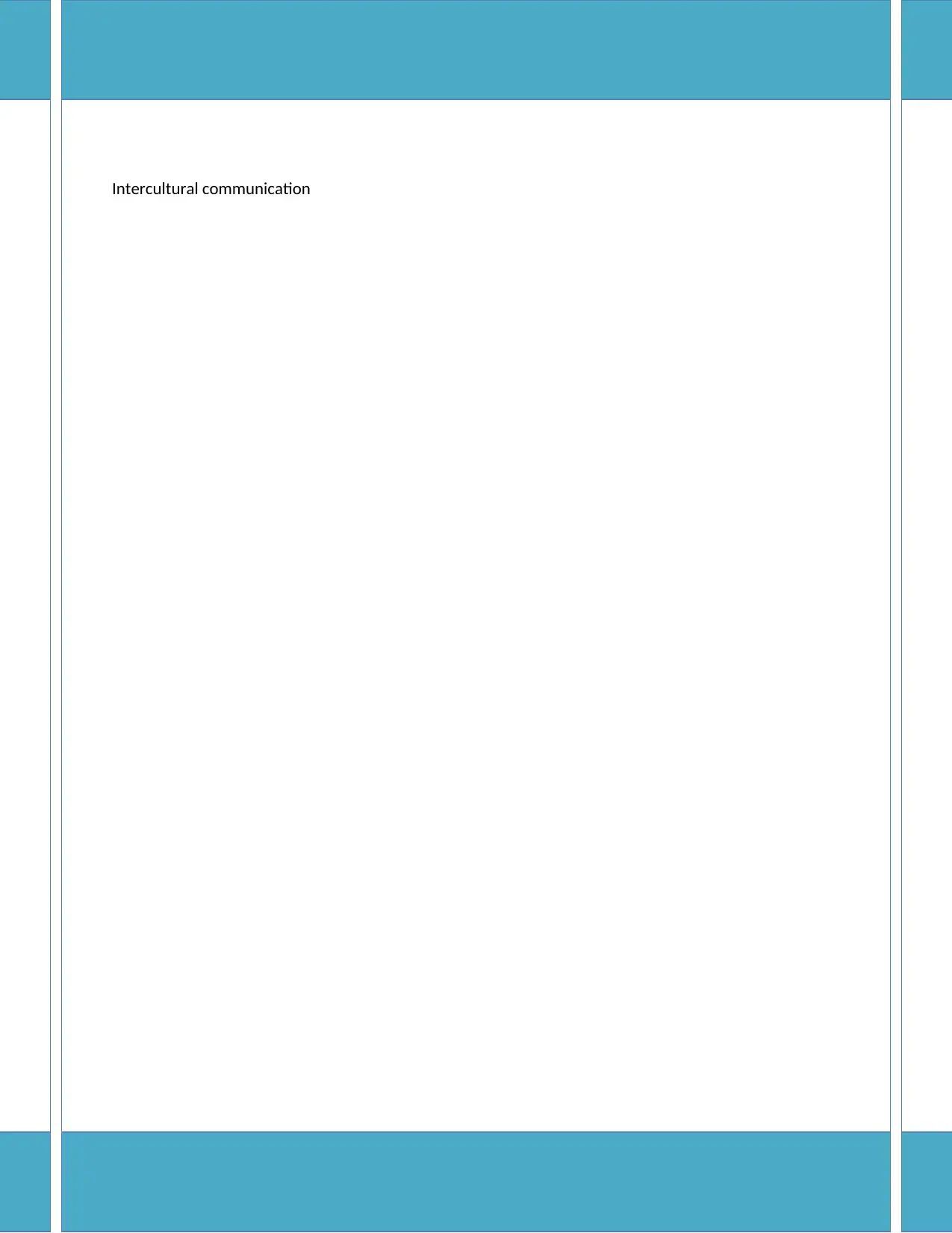
Intercultural communication
Paraphrase This Document
Need a fresh take? Get an instant paraphrase of this document with our AI Paraphraser
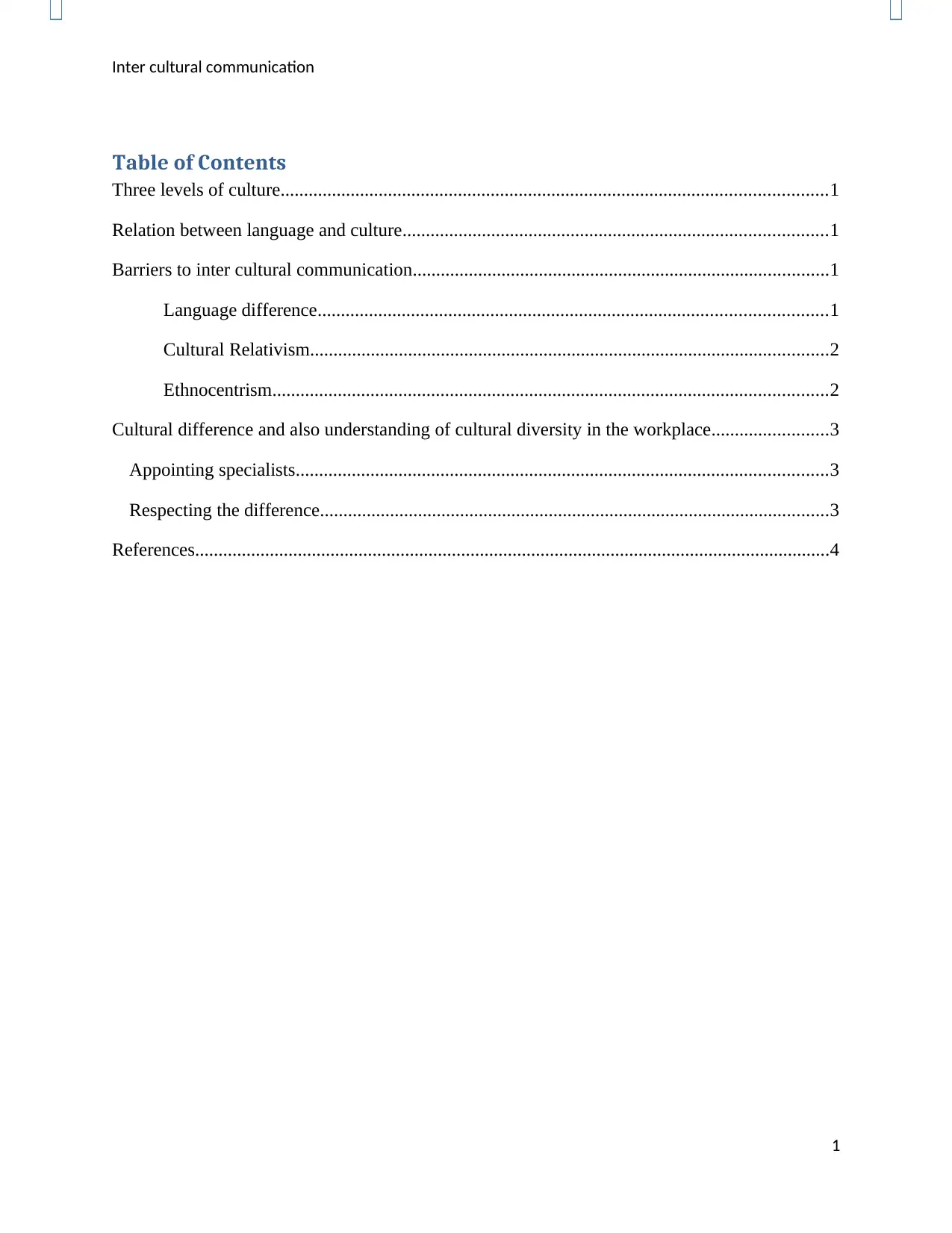
Inter cultural communication
Table of Contents
Three levels of culture.....................................................................................................................1
Relation between language and culture...........................................................................................1
Barriers to inter cultural communication.........................................................................................1
Language difference.............................................................................................................1
Cultural Relativism...............................................................................................................2
Ethnocentrism.......................................................................................................................2
Cultural difference and also understanding of cultural diversity in the workplace.........................3
Appointing specialists..................................................................................................................3
Respecting the difference.............................................................................................................3
References........................................................................................................................................4
1
Table of Contents
Three levels of culture.....................................................................................................................1
Relation between language and culture...........................................................................................1
Barriers to inter cultural communication.........................................................................................1
Language difference.............................................................................................................1
Cultural Relativism...............................................................................................................2
Ethnocentrism.......................................................................................................................2
Cultural difference and also understanding of cultural diversity in the workplace.........................3
Appointing specialists..................................................................................................................3
Respecting the difference.............................................................................................................3
References........................................................................................................................................4
1
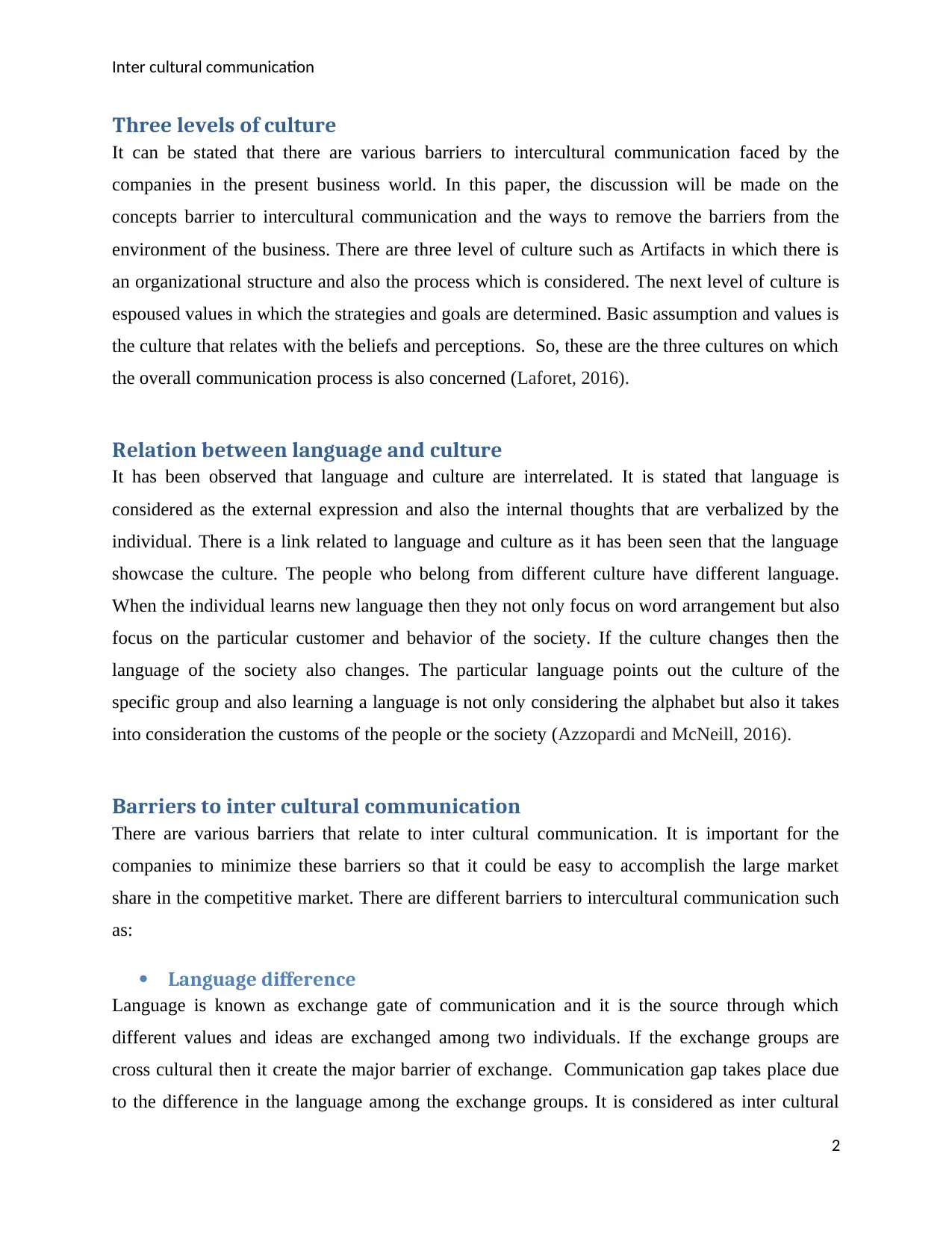
Inter cultural communication
Three levels of culture
It can be stated that there are various barriers to intercultural communication faced by the
companies in the present business world. In this paper, the discussion will be made on the
concepts barrier to intercultural communication and the ways to remove the barriers from the
environment of the business. There are three level of culture such as Artifacts in which there is
an organizational structure and also the process which is considered. The next level of culture is
espoused values in which the strategies and goals are determined. Basic assumption and values is
the culture that relates with the beliefs and perceptions. So, these are the three cultures on which
the overall communication process is also concerned (Laforet, 2016).
Relation between language and culture
It has been observed that language and culture are interrelated. It is stated that language is
considered as the external expression and also the internal thoughts that are verbalized by the
individual. There is a link related to language and culture as it has been seen that the language
showcase the culture. The people who belong from different culture have different language.
When the individual learns new language then they not only focus on word arrangement but also
focus on the particular customer and behavior of the society. If the culture changes then the
language of the society also changes. The particular language points out the culture of the
specific group and also learning a language is not only considering the alphabet but also it takes
into consideration the customs of the people or the society (Azzopardi and McNeill, 2016).
Barriers to inter cultural communication
There are various barriers that relate to inter cultural communication. It is important for the
companies to minimize these barriers so that it could be easy to accomplish the large market
share in the competitive market. There are different barriers to intercultural communication such
as:
Language difference
Language is known as exchange gate of communication and it is the source through which
different values and ideas are exchanged among two individuals. If the exchange groups are
cross cultural then it create the major barrier of exchange. Communication gap takes place due
to the difference in the language among the exchange groups. It is considered as inter cultural
2
Three levels of culture
It can be stated that there are various barriers to intercultural communication faced by the
companies in the present business world. In this paper, the discussion will be made on the
concepts barrier to intercultural communication and the ways to remove the barriers from the
environment of the business. There are three level of culture such as Artifacts in which there is
an organizational structure and also the process which is considered. The next level of culture is
espoused values in which the strategies and goals are determined. Basic assumption and values is
the culture that relates with the beliefs and perceptions. So, these are the three cultures on which
the overall communication process is also concerned (Laforet, 2016).
Relation between language and culture
It has been observed that language and culture are interrelated. It is stated that language is
considered as the external expression and also the internal thoughts that are verbalized by the
individual. There is a link related to language and culture as it has been seen that the language
showcase the culture. The people who belong from different culture have different language.
When the individual learns new language then they not only focus on word arrangement but also
focus on the particular customer and behavior of the society. If the culture changes then the
language of the society also changes. The particular language points out the culture of the
specific group and also learning a language is not only considering the alphabet but also it takes
into consideration the customs of the people or the society (Azzopardi and McNeill, 2016).
Barriers to inter cultural communication
There are various barriers that relate to inter cultural communication. It is important for the
companies to minimize these barriers so that it could be easy to accomplish the large market
share in the competitive market. There are different barriers to intercultural communication such
as:
Language difference
Language is known as exchange gate of communication and it is the source through which
different values and ideas are exchanged among two individuals. If the exchange groups are
cross cultural then it create the major barrier of exchange. Communication gap takes place due
to the difference in the language among the exchange groups. It is considered as inter cultural
2
⊘ This is a preview!⊘
Do you want full access?
Subscribe today to unlock all pages.

Trusted by 1+ million students worldwide
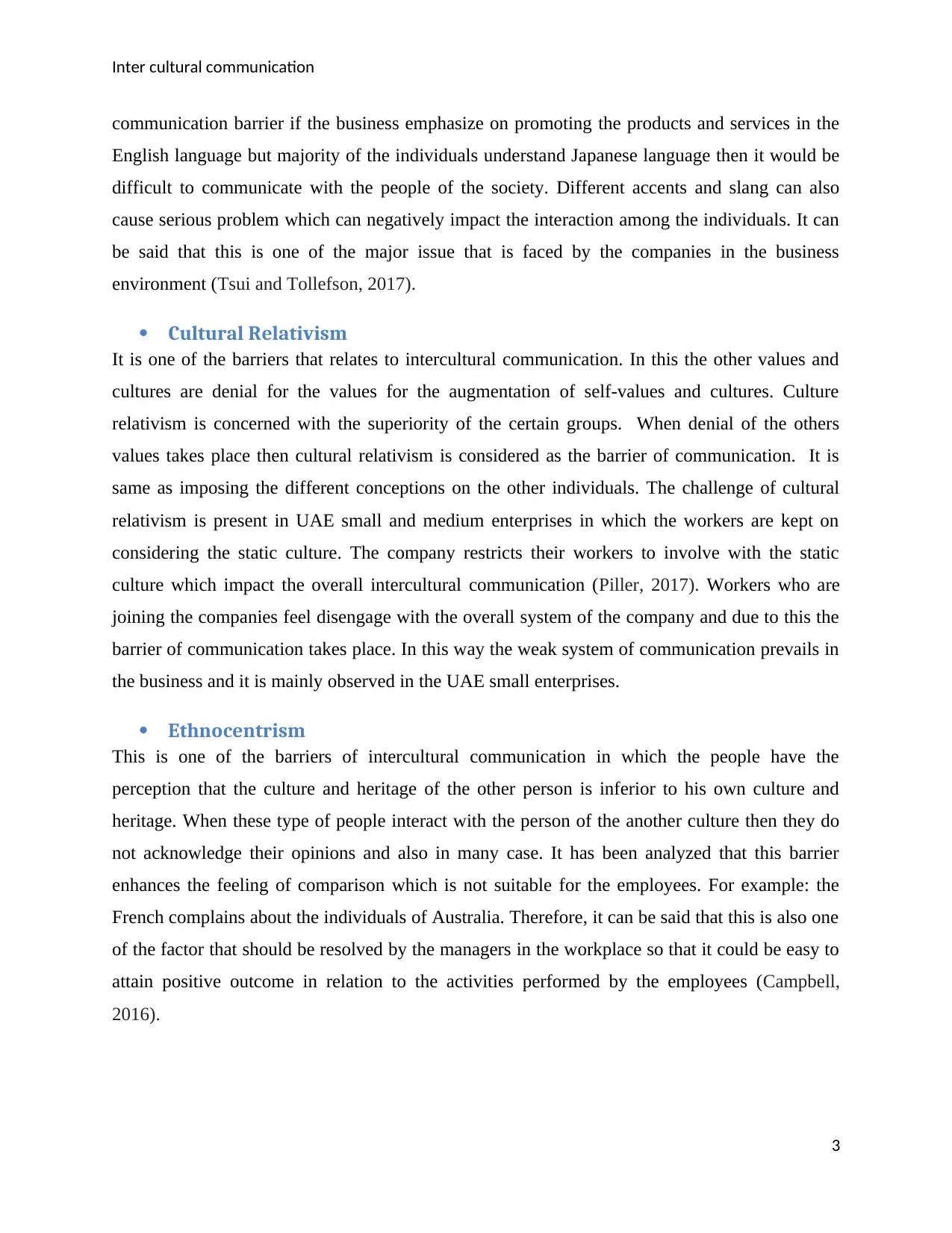
Inter cultural communication
communication barrier if the business emphasize on promoting the products and services in the
English language but majority of the individuals understand Japanese language then it would be
difficult to communicate with the people of the society. Different accents and slang can also
cause serious problem which can negatively impact the interaction among the individuals. It can
be said that this is one of the major issue that is faced by the companies in the business
environment (Tsui and Tollefson, 2017).
Cultural Relativism
It is one of the barriers that relates to intercultural communication. In this the other values and
cultures are denial for the values for the augmentation of self-values and cultures. Culture
relativism is concerned with the superiority of the certain groups. When denial of the others
values takes place then cultural relativism is considered as the barrier of communication. It is
same as imposing the different conceptions on the other individuals. The challenge of cultural
relativism is present in UAE small and medium enterprises in which the workers are kept on
considering the static culture. The company restricts their workers to involve with the static
culture which impact the overall intercultural communication (Piller, 2017). Workers who are
joining the companies feel disengage with the overall system of the company and due to this the
barrier of communication takes place. In this way the weak system of communication prevails in
the business and it is mainly observed in the UAE small enterprises.
Ethnocentrism
This is one of the barriers of intercultural communication in which the people have the
perception that the culture and heritage of the other person is inferior to his own culture and
heritage. When these type of people interact with the person of the another culture then they do
not acknowledge their opinions and also in many case. It has been analyzed that this barrier
enhances the feeling of comparison which is not suitable for the employees. For example: the
French complains about the individuals of Australia. Therefore, it can be said that this is also one
of the factor that should be resolved by the managers in the workplace so that it could be easy to
attain positive outcome in relation to the activities performed by the employees (Campbell,
2016).
3
communication barrier if the business emphasize on promoting the products and services in the
English language but majority of the individuals understand Japanese language then it would be
difficult to communicate with the people of the society. Different accents and slang can also
cause serious problem which can negatively impact the interaction among the individuals. It can
be said that this is one of the major issue that is faced by the companies in the business
environment (Tsui and Tollefson, 2017).
Cultural Relativism
It is one of the barriers that relates to intercultural communication. In this the other values and
cultures are denial for the values for the augmentation of self-values and cultures. Culture
relativism is concerned with the superiority of the certain groups. When denial of the others
values takes place then cultural relativism is considered as the barrier of communication. It is
same as imposing the different conceptions on the other individuals. The challenge of cultural
relativism is present in UAE small and medium enterprises in which the workers are kept on
considering the static culture. The company restricts their workers to involve with the static
culture which impact the overall intercultural communication (Piller, 2017). Workers who are
joining the companies feel disengage with the overall system of the company and due to this the
barrier of communication takes place. In this way the weak system of communication prevails in
the business and it is mainly observed in the UAE small enterprises.
Ethnocentrism
This is one of the barriers of intercultural communication in which the people have the
perception that the culture and heritage of the other person is inferior to his own culture and
heritage. When these type of people interact with the person of the another culture then they do
not acknowledge their opinions and also in many case. It has been analyzed that this barrier
enhances the feeling of comparison which is not suitable for the employees. For example: the
French complains about the individuals of Australia. Therefore, it can be said that this is also one
of the factor that should be resolved by the managers in the workplace so that it could be easy to
attain positive outcome in relation to the activities performed by the employees (Campbell,
2016).
3
Paraphrase This Document
Need a fresh take? Get an instant paraphrase of this document with our AI Paraphraser
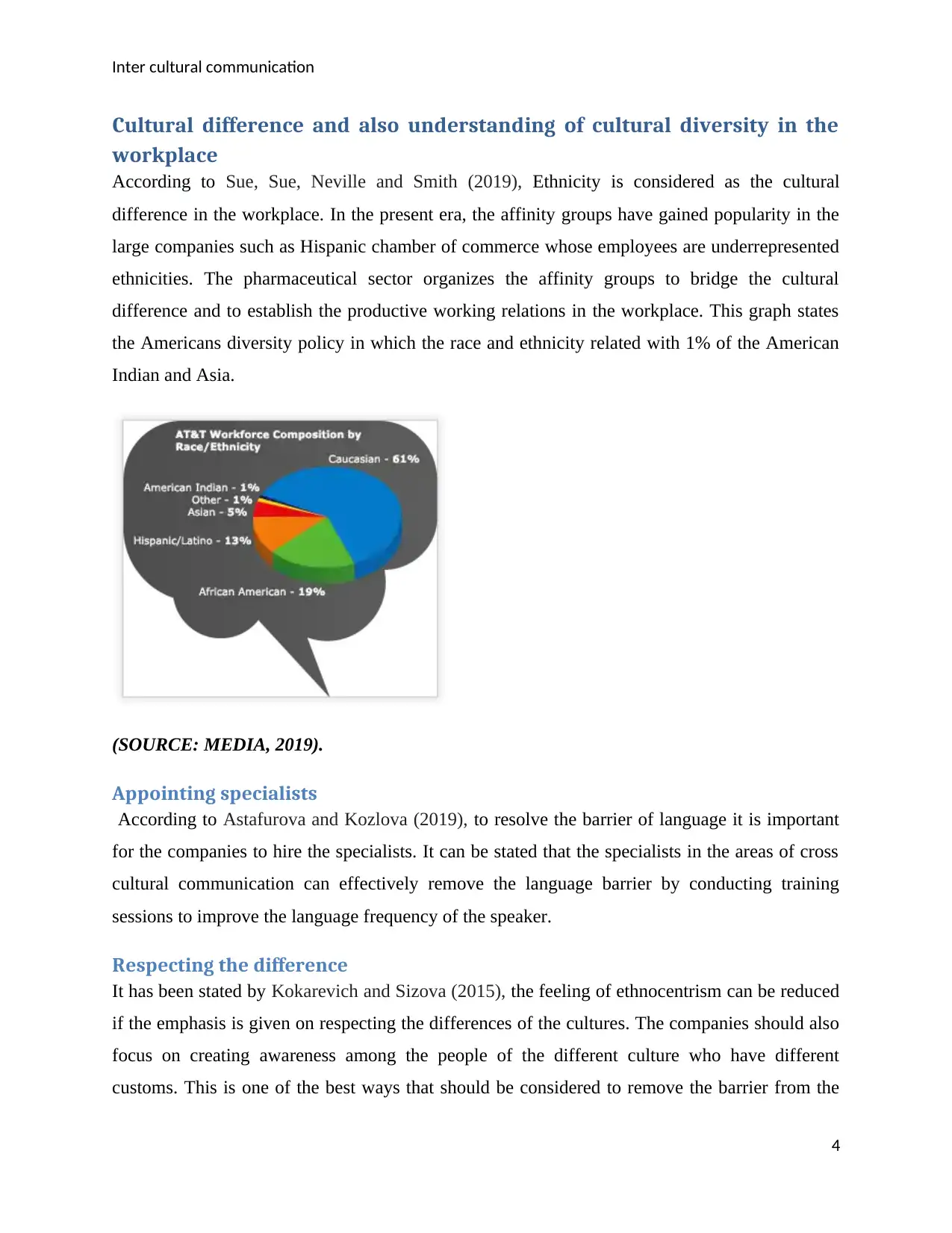
Inter cultural communication
Cultural difference and also understanding of cultural diversity in the
workplace
According to Sue, Sue, Neville and Smith (2019), Ethnicity is considered as the cultural
difference in the workplace. In the present era, the affinity groups have gained popularity in the
large companies such as Hispanic chamber of commerce whose employees are underrepresented
ethnicities. The pharmaceutical sector organizes the affinity groups to bridge the cultural
difference and to establish the productive working relations in the workplace. This graph states
the Americans diversity policy in which the race and ethnicity related with 1% of the American
Indian and Asia.
(SOURCE: MEDIA, 2019).
Appointing specialists
According to Astafurova and Kozlova (2019), to resolve the barrier of language it is important
for the companies to hire the specialists. It can be stated that the specialists in the areas of cross
cultural communication can effectively remove the language barrier by conducting training
sessions to improve the language frequency of the speaker.
Respecting the difference
It has been stated by Kokarevich and Sizova (2015), the feeling of ethnocentrism can be reduced
if the emphasis is given on respecting the differences of the cultures. The companies should also
focus on creating awareness among the people of the different culture who have different
customs. This is one of the best ways that should be considered to remove the barrier from the
4
Cultural difference and also understanding of cultural diversity in the
workplace
According to Sue, Sue, Neville and Smith (2019), Ethnicity is considered as the cultural
difference in the workplace. In the present era, the affinity groups have gained popularity in the
large companies such as Hispanic chamber of commerce whose employees are underrepresented
ethnicities. The pharmaceutical sector organizes the affinity groups to bridge the cultural
difference and to establish the productive working relations in the workplace. This graph states
the Americans diversity policy in which the race and ethnicity related with 1% of the American
Indian and Asia.
(SOURCE: MEDIA, 2019).
Appointing specialists
According to Astafurova and Kozlova (2019), to resolve the barrier of language it is important
for the companies to hire the specialists. It can be stated that the specialists in the areas of cross
cultural communication can effectively remove the language barrier by conducting training
sessions to improve the language frequency of the speaker.
Respecting the difference
It has been stated by Kokarevich and Sizova (2015), the feeling of ethnocentrism can be reduced
if the emphasis is given on respecting the differences of the cultures. The companies should also
focus on creating awareness among the people of the different culture who have different
customs. This is one of the best ways that should be considered to remove the barrier from the
4
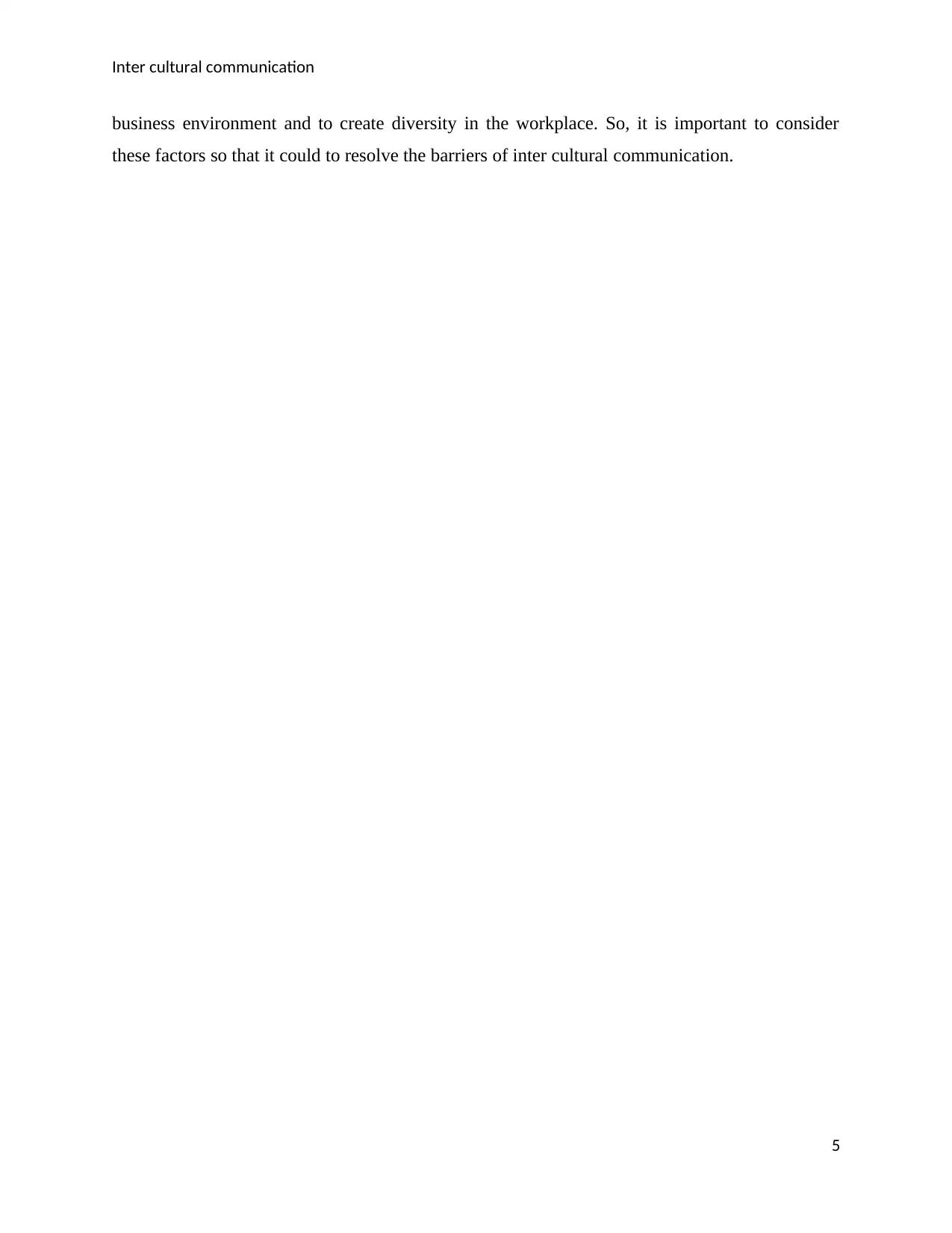
Inter cultural communication
business environment and to create diversity in the workplace. So, it is important to consider
these factors so that it could to resolve the barriers of inter cultural communication.
5
business environment and to create diversity in the workplace. So, it is important to consider
these factors so that it could to resolve the barriers of inter cultural communication.
5
⊘ This is a preview!⊘
Do you want full access?
Subscribe today to unlock all pages.

Trusted by 1+ million students worldwide
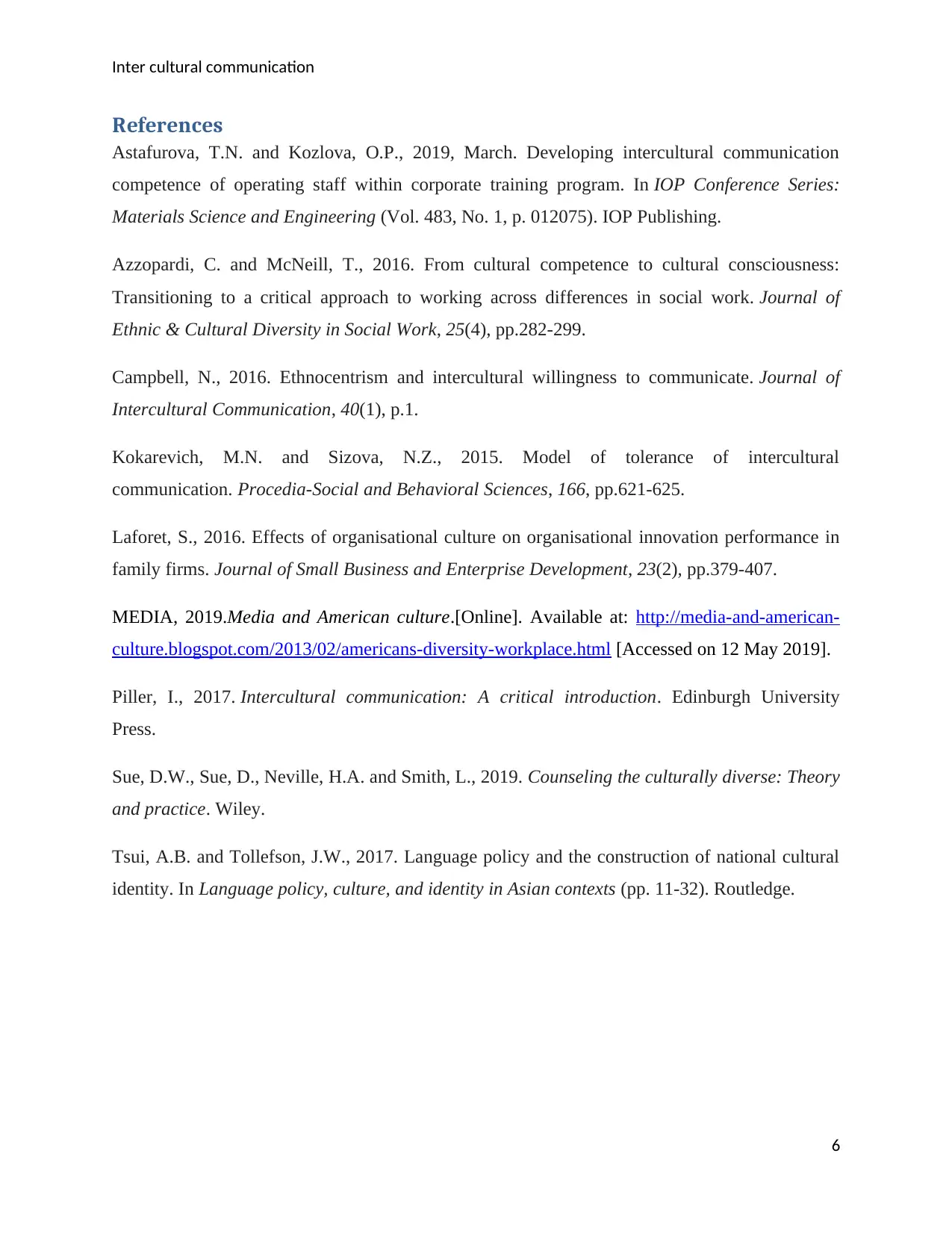
Inter cultural communication
References
Astafurova, T.N. and Kozlova, O.P., 2019, March. Developing intercultural communication
competence of operating staff within corporate training program. In IOP Conference Series:
Materials Science and Engineering (Vol. 483, No. 1, p. 012075). IOP Publishing.
Azzopardi, C. and McNeill, T., 2016. From cultural competence to cultural consciousness:
Transitioning to a critical approach to working across differences in social work. Journal of
Ethnic & Cultural Diversity in Social Work, 25(4), pp.282-299.
Campbell, N., 2016. Ethnocentrism and intercultural willingness to communicate. Journal of
Intercultural Communication, 40(1), p.1.
Kokarevich, M.N. and Sizova, N.Z., 2015. Model of tolerance of intercultural
communication. Procedia-Social and Behavioral Sciences, 166, pp.621-625.
Laforet, S., 2016. Effects of organisational culture on organisational innovation performance in
family firms. Journal of Small Business and Enterprise Development, 23(2), pp.379-407.
MEDIA, 2019.Media and American culture.[Online]. Available at: http://media-and-american-
culture.blogspot.com/2013/02/americans-diversity-workplace.html [Accessed on 12 May 2019].
Piller, I., 2017. Intercultural communication: A critical introduction. Edinburgh University
Press.
Sue, D.W., Sue, D., Neville, H.A. and Smith, L., 2019. Counseling the culturally diverse: Theory
and practice. Wiley.
Tsui, A.B. and Tollefson, J.W., 2017. Language policy and the construction of national cultural
identity. In Language policy, culture, and identity in Asian contexts (pp. 11-32). Routledge.
6
References
Astafurova, T.N. and Kozlova, O.P., 2019, March. Developing intercultural communication
competence of operating staff within corporate training program. In IOP Conference Series:
Materials Science and Engineering (Vol. 483, No. 1, p. 012075). IOP Publishing.
Azzopardi, C. and McNeill, T., 2016. From cultural competence to cultural consciousness:
Transitioning to a critical approach to working across differences in social work. Journal of
Ethnic & Cultural Diversity in Social Work, 25(4), pp.282-299.
Campbell, N., 2016. Ethnocentrism and intercultural willingness to communicate. Journal of
Intercultural Communication, 40(1), p.1.
Kokarevich, M.N. and Sizova, N.Z., 2015. Model of tolerance of intercultural
communication. Procedia-Social and Behavioral Sciences, 166, pp.621-625.
Laforet, S., 2016. Effects of organisational culture on organisational innovation performance in
family firms. Journal of Small Business and Enterprise Development, 23(2), pp.379-407.
MEDIA, 2019.Media and American culture.[Online]. Available at: http://media-and-american-
culture.blogspot.com/2013/02/americans-diversity-workplace.html [Accessed on 12 May 2019].
Piller, I., 2017. Intercultural communication: A critical introduction. Edinburgh University
Press.
Sue, D.W., Sue, D., Neville, H.A. and Smith, L., 2019. Counseling the culturally diverse: Theory
and practice. Wiley.
Tsui, A.B. and Tollefson, J.W., 2017. Language policy and the construction of national cultural
identity. In Language policy, culture, and identity in Asian contexts (pp. 11-32). Routledge.
6
1 out of 7
Related Documents
Your All-in-One AI-Powered Toolkit for Academic Success.
+13062052269
info@desklib.com
Available 24*7 on WhatsApp / Email
![[object Object]](/_next/static/media/star-bottom.7253800d.svg)
Unlock your academic potential
Copyright © 2020–2025 A2Z Services. All Rights Reserved. Developed and managed by ZUCOL.





